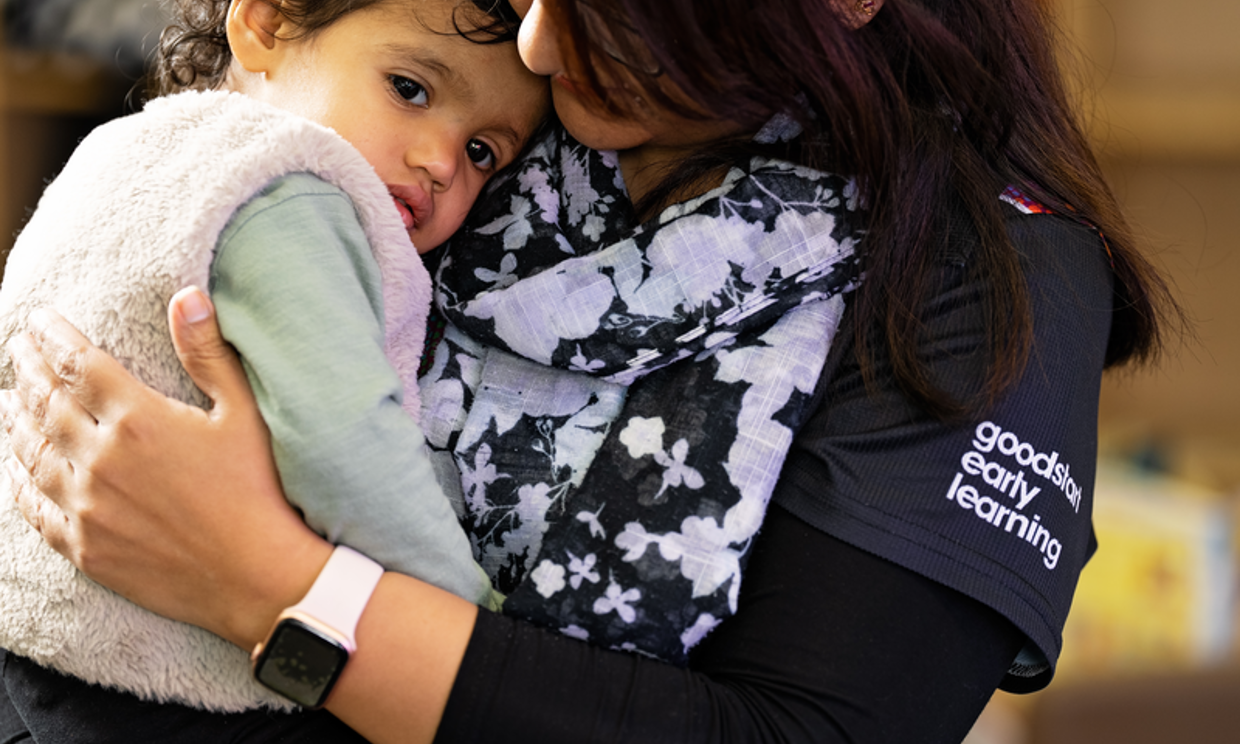Separation anxiety is a normal part of childhood development, and it's something most parents will experience at some point. Whether your child is starting at a new child care centre, transitioning between rooms, or dealing with significant life changes like moving house or the arrival of a new sibling, it's natural for them to feel anxious. At Goodstart, we understand how challenging this phase can be for both children and parents. However, with the proper support, your child can transition smoothly and gain confidence in their new environment.
Understanding separation anxiety in toddlers
Separation anxiety typically peaks between 10 months and two years, though it can occur at any stage, especially during transitions. It's linked to a child's developing sense of object permanence—the understanding that things and people still exist even when they can't see them. Once children grasp this, they begin to feel anxiety when separated from their parents, leading to emotional goodbyes.
While separation anxiety is usually a temporary phase, it can be triggered by stressful events like moving house or changes in routine. In rare cases, it may develop into a separation anxiety disorder. It's always best to consult a healthcare professional if parents have concerns.
Common triggers for separation anxiety
Specific transitions can heighten separation anxiety, including:
- Starting or changing early learning centres.
- Moving to a new room within the same centre.
- Significant family changes, like the arrival of a new baby or moving house.
It's important to remember that while separation anxiety can feel overwhelming, it's a phase that most children will grow through with time. And with the right strategies, you can help your child feel secure and confident during this period.
How separation anxiety unfolds in an early learning environment
Andrea Hayes is the centre director at Goodstart Kelso - Riverway Drive. She holds a Bachelor of Psychology with a particular interest in children’s development and advocacy, resilience teaching, attachment links to personality development, and behaviour management.
Andrea says "It is normal infant development to show strong attachment and preference for one specific individual as they begin to display anxiety around strangers from 7 – 11 months. This links to the importance of our Key Educators who respond quickly and consistently which is a vital part of developing trusting relationships which is essential in reducing separation anxiety."
"Separation anxiety can also manifest as tantrums and refusing to go to daycare and doesn’t mean their child isn’t having a good day once settled after drop-off although we understand how stressful this is for families. Our Educators are ready to discuss strategies to help parents and children navigate these feelings during this phase."
"It is normal for families to feel anxious themselves and are encouraged to call the centre for checks if they need to, and/or Educators can let families know once their child has settled to ease their anxiety"
"Some children will do really well for the first few weeks in care, then may appear to ‘suddenly develop’ separation anxiety. This is also quite normal as children are still actively settling in, the newness has worn off, and they are processing their understanding of these big changes becoming permanent."
"To help ease separation anxiety, parents can give their child a small token such as a hair tie, handkerchief, or asking their child to help them by caring for that item until they pick them up after work. This gives the child a sense of purpose at drop off and is a strong visual assurance that their parent is returning."

It is normal infant development to show strong attachment and preference for one specific individual as they begin to display anxiety around strangers from 7 – 11 months. This links to the importance of our Key Educators who respond quickly and consistently which is a vital part of developing trusting relationships which is essential in reducing separation anxiety.
Tips for easing separation anxiety
Goodstart recognises the importance of Key Educators who provide consistent and responsive care, building trusting relationships that help reduce separation anxiety. The following strategies are designed to help your child with the transition to early learning:
Strategies to support families
1. Say a calm goodbye
It might be tempting to slip away unnoticed, but this can be unsettling for your child. We recommend creating a consistent goodbye routine, such as a memorable phrase, hug, or handshake, to help ease the transition and reassure your child that you'll be back.
2. Establish a routine
Children thrive on predictability. A consistent morning routine such as breakfast, getting dressed, and packing their bag, will help your child feel more secure. Preparing the night before can also help reduce the morning rush, allowing you to focus on your child during drop-off. Stick to consistent arrival and departure times for added stability.
3. Familiarise your child with the new environment
Before your child's first day, we encourage families to visit the centre together. Take the time to explore the space, meet the educators, and engage with toys or activities. This helps your child feel more comfortable in their new environment and makes the first day less intimidating.
4. Communicate clearly and reassuringly
We believe in open communication. Explain what will happen in simple, reassuring terms: "You'll play with your friends, and I'll be back after work." This helps your child understand that the separation is temporary and part of a predictable routine.
5. Work together with educators
Collaboration is key. We're committed to working closely with families to support their child's transition. Share your child's drop-off routine, any comfort items they use, and strategies that help them settle. Consistent support from home and the centre will give your child the security they need.
6. Keep goodbyes brief and calm
Long goodbyes can make the separation harder. We recommend keeping goodbyes brief, calm, and confident. Say goodbye, then allow an educator to step in and engage your child with a favourite activity or toy.
7. Stay calm and positive
Children are susceptible to their parents' emotions. By staying calm and confident, you send a reassuring message that everything will be okay. It's perfectly normal to feel emotional, but it's best to keep those feelings in check until you've left.
8. Spend quality time together
After pick-up, make time to reconnect. Ask about your child's day, celebrate their small successes, and reassure them you're proud of their progress. This will reinforce their sense of security and help them adjust to the centre more smoothly.
A shared effort
Separation anxiety is a team effort involving parents, children, and educators. We're here to guide families through this phase, providing helpful strategies and supporting smooth transitions. Our orientation process includes opportunities for children to visit the centre before their first day, allowing them to get comfortable with the environment, educators, and routine.
Throughout the transition, we communicate regularly with parents through updates, photos, and videos via our Storypark app. This allows you to stay connected with your child's experiences and be reassured that they are safe, engaged, and enjoying their time at Goodstart.
Supporting resilience
Every child responds to separation differently; some children may take longer to adjust. At Goodstart, we are flexible and will tailor the approach to suit your child's needs. Whether starting with shorter days, gradually increasing their time at the centre, or bringing comfort items from home, we'll work with you to ensure a positive experience.
We are committed to providing a nurturing, supportive environment where every child can thrive. We help children build resilience, independence, and confidence as they navigate transitions by fostering empathy, consistency, and clear communication.


